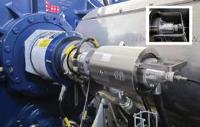 Add My Company
Add My Company
Sign In

The BGB Axial Multimode and Singlemode Fibre Optic Rotary Joints, “Optilinc” have been rigorously tested by Deutsch UK Ltd to EN2591-601, (Aerospace series - Elements of electrical and optical connection Part 601: Optical elements - Insertion loss) and to EIA standards. Optilinc was the first of the new generation of contactless slip rings to be produced and manufactured by BGB Engineering Ltd. Now with over four years of introducing it into various industries, the Optilinc range of FORJs are set to take on the major players in the contactless rotary joint market.
The Fibre Optic Rotary Joint (FORJ) is the optical equivalent of the electrical slip ring. It allows uninterrupted transmission of an optical signal while rotating along the fibre axis. FORJs’ are widely used in missile guidance systems, remotely operated vehicles (ROVs), and many other field applications where a twist-free fibre cable is essential.
The Fibre Optic Rotary Joint is ideal for high speed data-transfer on many applications, in particular, data transfer from the nacelle of a Wind turbine. Constructed in stainless steel, BGB’s ‘Optilinc’ has exceptional durability protecting the unit from dust and water ingress to IP68 and is not influenced by vibration, humidity, heat, magnetism or other typical slip ring disturbances. The unit can transfer bi-directional data at a rate up to, and beyond, 10Gb per second and can be offered with media converters, switches and wavelength division multiplexers (WDMs) to suit users’ protocols and requirements.
“Multimode units available with ST or RSC connectors are now in production together with bespoke slip ring units and media converters manufactured to customers’ needs and environmental requirements,” Mark Chappell, R&D Manager at BGB Engineering said. “The RSC connector has been fully developed in partnership with Deutsch UK to expand our customer base into fields such as Military, Medical, Oil & Gas and Aerospace. Singlemode units are available with ST connectors.”
Optical fibre is proven to have far wider bandwidth than any other media known such as wireless, copper wire, and sonar. A single strand of optical fibre can easily replace a large bundle of copper wires while boosting system bandwidth.
The basic concept of the FORJ is essentially very simple, although a practical implementation requires considerable expertise and attention to detail. This simplicity does however lead to robust and reliable products that can be adapted to a wide variety of applications.
Unlike its counter parts an optical fibre is extremely secure. Even when the fibre is interfered with successfully, it would have created enough disturbances in the system to be detected. Optical fibre has been the most preferred transmission medium in secure systems worldwide especially military and telecom applications.
Electrical current can be extremely harmful in the environment where flammable or explosive materials are used or stored. Optical fibre provides an ideal channel to collect useful information such as temperature, pressure, and humidity.
Combined with electrical slip rings, FORJ’s add a new dimension to traditional rotary joints. BGBs Optilinc FORJ can be combined with existing traditional long standing proven BGB slip ring packages to bridge the gap of older units and to future-proof systems allowing ample bandwidth to the end user.
By providing an optical slip ring together with media converters to suit the customer’s existing data network, the Optilinc FORJ provides a transparent route for the user to extend his bandwidth and data integrity.
BGB have married the high bandwidth of an optical slip ring with their extensive background in power slip rings to offer an integrated unit with power and data transfer as well as an optional shaft position encoder.
More information regarding Optilinc can be found on the BGB Innovation website, under the BGB Telemetry banner (www.bgbinnovation.com). As well as Optilinc, BGB Telemetry is the ‘future technologies’ section of BGB and concentrates on further innovations such as induction and other contactless methods of transferring power, data and signal through rotary applications.
BGB are a UK based high precision electro-mechanical engineering company. The company has a long history expanding over 30 years in the innovative product development and manufacturing of slip ring components, slip ring assemblies and underwater lighting products. BGB maintains the position of strategic supplier to many of the major global wind turbine manufacturers in the supply of wind turbine slip rings and systems used in generators, pitch control, lightning suppression, and shaft grounding applications. Aside from its major position within the global wind turbine industry, BGB is a major supplier of slip ring components and assemblies to a variety of other industries including: wastewater treatment, material handling, construction machinery, packaging machinery, industrial machinery, amongst many others.
“The growing range of Fibre Optic Rotary Joints have been a major technological step forward for BGB,” says David R Holt, Managing Director of BGB. “The units expand our already large product offering to many of our industry sectors and will hopefully gain us access to previously un-chartered markets such as medical, military and ROVs . Our customers expect us to lead and keep at the forefront of modern technology and the Optilinc units show that not only can we achieve outstanding innovation, but also provide it to the market at a very low cost.”
The Optilinc system has been thoroughly developed and tested over the past six years in BGB's R&D ‘Clean’ room and external test houses including, TRAC Global, Alphatec and Deutsch UK. BGB has invested heavily in the new system and has worked in collaboration with the UK’s leading Optical Physicists to develop a highly innovative Fibre Optic Rotary Joint.
As fibre optic technology advances, more and more traditional slip ring users will benefit from Fibre Optic Rotary Joints in their new systems as the need for bandwidth continually increases.
For more information on High Speed Data Transfers Aided by Fibre Optic Technology talk to BGB
Enquire Now
List your company on FindTheNeedle.

